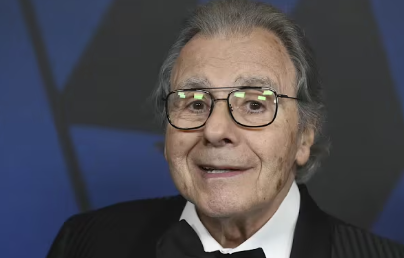The music legend behind one of the most iconic themes ever, passed at 93—his story is just as powerful
- Replies 0
It began as a single beat—quirky, off-kilter, unforgettable. That rhythm became the heartbeat of an entire franchise, its sound instantly recognizable across generations.
Behind that famed motif stood a restless creator whose story reached far beyond just one melody.
This week, the world bids farewell to the legendary composer, who passed away at the age of 93, leaving behind a legacy that stretches far beyond a single unforgettable tune.
Born Boris Claudio Schifrin in Buenos Aires to a musical family—his father was the concertmaster of the city’s philharmonic—Lalo’s life was steeped in melody from the very beginning.
He was classically trained, but his curiosity and talent couldn’t be contained by any one genre.
After studying law and music in Argentina, he set his sights on the Paris Conservatory, where he learned from the legendary Olivier Messiaen.
It was there that Schifrin’s love for harmony, rhythm, and experimentation truly blossomed.
Returning to Argentina, he formed his own concert band, but it wasn’t long before jazz legend Dizzy Gillespie heard him play and invited him to join his quintet.
By 1958, Schifrin was in the United States, composing the acclaimed Gillespiana and performing with jazz greats like Count Basie, Sarah Vaughan, Ella Fitzgerald, and Stan Getz.

Of course, it’s impossible (pun intended!) to talk about Lalo Schifrin without mentioning the theme that made him a household name.
When the producers of the new TV show Mission: Impossible asked for something “exciting, almost like a logo,” Schifrin delivered a piece in the unusual 5/4 time signature—a musical oddity that instantly set the show apart.
The theme’s relentless rhythm, paired with the iconic burning fuse, became television history.
The tune was so infectious that it climbed to No. 41 on the Billboard Hot 100 in 1968 and was later covered by U2’s Adam Clayton and Larry Mullen Jr. for the 1996 film adaptation, earning a Grammy nomination.
The theme has been reimagined by composers like Danny Elfman, Hans Zimmer, and Michael Giacchino for the blockbuster film franchise, but Schifrin’s original DNA remains at the heart of every version.
The New Yorker critic Anthony Lane once called it “only the most contagious tune ever heard by mortal ears.” And who are we to argue?
Still, Schifrin was never content to rest on his laurels. Throughout his career, he scored more than 100 films and TV shows, earning six Oscar nominations and four Grammy wins.
His credits read like a tour through Hollywood history: Cool Hand Luke, The Fox, Voyage of the Damned, The Amityville Horror, The Sting II, Dirty Harry, Rush Hour, and so many more.
Always a master of mood, Schifrin was able to conjure tension, romance, or terror with a few well-chosen notes.
For Dirty Harry, he famously wrote the main theme not for Clint Eastwood’s hero, but for the villain Scorpio—proving that Schifrin always saw things from a fresh angle.
His work extended far beyond Hollywood.
Schifrin wrote the grand finale for the 1990 World Cup in Italy, where the Three Tenors—Plácido Domingo, Luciano Pavarotti, and José Carreras—sang together for the first time, creating one of the best-selling classical albums in history.
He conducted orchestras from London to Vienna, composed for the Pan American Games, and even wrote a choral symphony in the ancient Nahuatl language, performed at the Teotihuacan pyramids in Mexico.
Also read: Why does music make us feel things?
Schifrin’s trophy shelf was as eclectic as his career.
He won Grammys for jazz suites and TV scores, received an honorary Oscar in 2018, and was honored by the Latin Recording Academy.
In 2017, his Mission: Impossible theme was inducted into the Grammy Hall of Fame—a fitting tribute to a piece of music that has thrilled generations.
He was also a mentor and inspiration to younger composers.
Michael Giacchino, who scored later Mission: Impossible films, recalled nervously asking Schifrin for his blessing. Schifrin’s advice? “Just have fun with it.”
That spirit of joy and creativity defined his entire career.
Lalo Schifrin’s story is one of relentless curiosity, boundary-breaking creativity, and a deep love for the art of music.
He moved effortlessly between jazz clubs and concert halls, Hollywood studios and world stages, always bringing his unique voice to every project.
He is survived by his wife Donna, sons William and Ryan, and daughter Frances.
As Schifrin himself once said, “There’s something magic in the art of music anyway.”
Read next: Legendary composer behind “Annie” and “Bye Bye Birdie” passes away at 96

Did you grow up watching Mission: Impossible? Do you still catch yourself humming along to that unforgettable beat? Do you have a favorite Schifrin score or memory?
Behind that famed motif stood a restless creator whose story reached far beyond just one melody.
This week, the world bids farewell to the legendary composer, who passed away at the age of 93, leaving behind a legacy that stretches far beyond a single unforgettable tune.
Born Boris Claudio Schifrin in Buenos Aires to a musical family—his father was the concertmaster of the city’s philharmonic—Lalo’s life was steeped in melody from the very beginning.
He was classically trained, but his curiosity and talent couldn’t be contained by any one genre.
After studying law and music in Argentina, he set his sights on the Paris Conservatory, where he learned from the legendary Olivier Messiaen.
It was there that Schifrin’s love for harmony, rhythm, and experimentation truly blossomed.
Returning to Argentina, he formed his own concert band, but it wasn’t long before jazz legend Dizzy Gillespie heard him play and invited him to join his quintet.
By 1958, Schifrin was in the United States, composing the acclaimed Gillespiana and performing with jazz greats like Count Basie, Sarah Vaughan, Ella Fitzgerald, and Stan Getz.

Schifrin’s ability to move seamlessly between jazz, classical, and popular music would become his trademark. Image source: ABC7 / YouTube
Of course, it’s impossible (pun intended!) to talk about Lalo Schifrin without mentioning the theme that made him a household name.
When the producers of the new TV show Mission: Impossible asked for something “exciting, almost like a logo,” Schifrin delivered a piece in the unusual 5/4 time signature—a musical oddity that instantly set the show apart.
The theme’s relentless rhythm, paired with the iconic burning fuse, became television history.
The tune was so infectious that it climbed to No. 41 on the Billboard Hot 100 in 1968 and was later covered by U2’s Adam Clayton and Larry Mullen Jr. for the 1996 film adaptation, earning a Grammy nomination.
The theme has been reimagined by composers like Danny Elfman, Hans Zimmer, and Michael Giacchino for the blockbuster film franchise, but Schifrin’s original DNA remains at the heart of every version.
The New Yorker critic Anthony Lane once called it “only the most contagious tune ever heard by mortal ears.” And who are we to argue?
Still, Schifrin was never content to rest on his laurels. Throughout his career, he scored more than 100 films and TV shows, earning six Oscar nominations and four Grammy wins.
His credits read like a tour through Hollywood history: Cool Hand Luke, The Fox, Voyage of the Damned, The Amityville Horror, The Sting II, Dirty Harry, Rush Hour, and so many more.
Always a master of mood, Schifrin was able to conjure tension, romance, or terror with a few well-chosen notes.
For Dirty Harry, he famously wrote the main theme not for Clint Eastwood’s hero, but for the villain Scorpio—proving that Schifrin always saw things from a fresh angle.
His work extended far beyond Hollywood.
Schifrin wrote the grand finale for the 1990 World Cup in Italy, where the Three Tenors—Plácido Domingo, Luciano Pavarotti, and José Carreras—sang together for the first time, creating one of the best-selling classical albums in history.
He conducted orchestras from London to Vienna, composed for the Pan American Games, and even wrote a choral symphony in the ancient Nahuatl language, performed at the Teotihuacan pyramids in Mexico.
Also read: Why does music make us feel things?
Schifrin’s trophy shelf was as eclectic as his career.
He won Grammys for jazz suites and TV scores, received an honorary Oscar in 2018, and was honored by the Latin Recording Academy.
In 2017, his Mission: Impossible theme was inducted into the Grammy Hall of Fame—a fitting tribute to a piece of music that has thrilled generations.
He was also a mentor and inspiration to younger composers.
Michael Giacchino, who scored later Mission: Impossible films, recalled nervously asking Schifrin for his blessing. Schifrin’s advice? “Just have fun with it.”
That spirit of joy and creativity defined his entire career.
Lalo Schifrin’s story is one of relentless curiosity, boundary-breaking creativity, and a deep love for the art of music.
He moved effortlessly between jazz clubs and concert halls, Hollywood studios and world stages, always bringing his unique voice to every project.
He is survived by his wife Donna, sons William and Ryan, and daughter Frances.
As Schifrin himself once said, “There’s something magic in the art of music anyway.”
Read next: Legendary composer behind “Annie” and “Bye Bye Birdie” passes away at 96
Key Takeaways
- Lalo Schifrin, the acclaimed Argentine composer best known for the iconic Mission: Impossible theme, has died at the age of 93.
- Schifrin’s career spanned jazz, classical, and film music, earning him four Grammys, an honorary Oscar, and collaborations with musical legends like Dizzy Gillespie, Ella Fitzgerald, and Count Basie.
- His instantly recognisable Mission: Impossible theme was groundbreaking in its 5/4 time signature and has been celebrated and adapted across decades of movies and TV, even entering the Grammy Hall of Fame.
- Beyond film and TV scores, Schifrin was an accomplished conductor and composer for major orchestras and international events, writing music for the World Cup, the Pan American Games, and even a choral symphony performed in Nahuatl at Teotihuacan.






